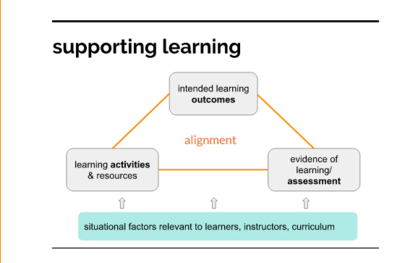Documentation:Digital Tattoo Student Orientation/Learning Design
Tutorial Design
Our tutorials are based on some solid learning design principles that include:
- empathy: Who are your students? Approaching your design challenge with information about who your learners are and their motivations, desires and problems or challenges is a good place to build from and revisit often.
- hook/motivation: Why would students be motivated to work their way through this tutorial? Does the title provoke interest? Is your subject matter relevant to students?
- learning outcome: What would you expect students will learn by working their way through the tutorial? Thinking through this piece in the planning stage will help you to align all tutorial components with the desired outcome.
- chunking: each element should be short, focused on the topic/ intended learning outcome and aligned to support the outcome (ie, video should provoke thinking and be relatable to students; quiz should support reflection on video content and extend learning by providing relevant feedback; explore section should provide supporting and current contextual information (discussion of related news stories, policies, practices or happenings); discuss section should provide provocative questions for engaging readers.
- alignment: alignment ensures that all elements of the tutorial work together to support the learning outcome you have defined.
Our Approach
Our approach to the aesthetic design of the tutorials is based on the TedEd Lessons for students and educators. We like that it kept all material on the same page; it was clean and simple (reducing cognitive load in learning design speak) and allowed us to review parts of the video as we were working through the quiz.
The Ted-Ed blog may also be a good source for material for your tutorial: https://blog.ed.ted.com/
What is Alignment?
Alignment (in our context) relates to the relationship between the learning goals for the tutorial content and the resources we develop to address each theme. We achieve alignment when all components support each other and offer the potential to support learning in a way that addresses beginning awareness of the issues and is meaningful to students.
Basically, we're looking to ensure that the content we develop offers the opportunity for people to do five things:
- learn basic concepts relevant to the theme presented (ie clickjacking)
- relate it to their own experience, online behavior
- consider any relevant action they may want to take to support their goals for their digital participation
- get introduced to resources/ideas they may want to explore further with suggested resources
- respond to a question - with a comment - contributing to a shared process of "figuring it out together" - a first step into networked learning.
Questions to guide your review of alignment for each component of the tutorial resources is below:
Themes
How might you go about choosing a theme for a tutorial?
- do some quick streeter interviews on your campus. What are some themes related to our digital lives that students are thinking about right now?
- find some inspiration. For example:
Video
- Does the video reveal the central issues relevant to the topic from your perspective?
Where can I find good/ re-usable video? Video embeds are considered links so you do not need to ensure the content is licensed for re-use UNLESS you intend to alter it in some way.
- YouTube
Think/ Self Assessment
- Do the self assessment questions provoke personal reflection on the topic AND relate to the content of the video? If not, suggest revisions in the notes section.
Explore
- Deeper Exploration: Given that the DT resource is intended to open up the issues for reflection (at an entry level), we also need to provide solid resources for a deeper look into the topic - this can include associated news stories or other readings.
- Are there suitable/current and active links in the explore section? If not, add/replace with relevant links.
- If there is a Think Before You Ink section on the Explore page you are reviewing - please make a note of it for updating later.
- Feedback: feedback on assessments should help build understanding and be useful to readers.
- Is the feedback on self assessment questions helpful in building understanding?
- Are cross links or references to other digital tattoo content (or external resources) provided?
Discuss
- Engagement: in general, when people view the content on the site, we want to provoke thinking/questioning.
- Are questions in Discuss limited to 1 or 2 provocative questions that align with the content and self assessment, but encourage people to share their experiences, perspectives, opinions, etc. ?
